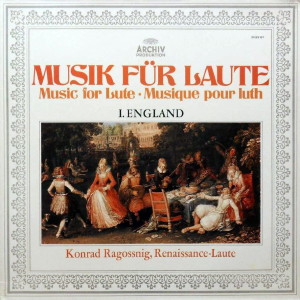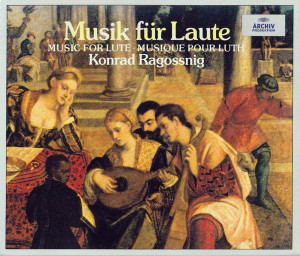 |
|
1 LP -
2533 157 - (p) 1974
|
 |
| 4 CD's -
447 727-2 - (c) 1995 |
|
| MUSIK FÜR LAUTE |
|
|
|
|
|
|
|
Lute Music of the Renaissance
- I. England · Angleterre
|
|
|
|
|
|
|
|
| John Dowland
(1562-1626) |
The King of
Denmark's Galliard |
Robert Dowland:
Varietie of Lute Lessons, London
1610; Ed. Edgar Hunt, Schott,
London 1957 |
|
2' 48" |
A1 |
| John Dowland |
Lachrimae
Antiquae Pavan |
David
Lumsden: An Anthology of
English Lute Music;
Schott, London 1954 |
|
5' 49" |
A2 |
| John Dowland |
Fantasia |
Robert Dowland:
Varietie of Lute Lessons, London
1610; Ed. Edgar Hunt, Schott,
London 1957 |
|
3' 47" |
A3 |
| John Dowland |
My Lady
Hunsdon's Puffe |
David
Lumsden: An Anthology of
English Lute Music;
Schott, London 1954 |
|
1' 42" |
A4 |
| John Dowland |
Melancholy
Galliard |
David
Lumsden: An Anthology of
English Lute Music;
Schott, London 1954 |
|
3' 42" |
A5 |
| John Dowland |
Mrs. Winter's
Jump |
Diana Poulton:
John Dowland - Seven Pieces;
Schott, London 1963 |
|
0' 45" |
A6 |
| John Dowland
|
Semper Dowland
semper dolens |
Ed. Helmut
Mönkemeyer: Die Tabulatur, Heft
13; Hofmeister, Hofheim 1967 |
|
3' 52" |
A7 |
| John Dowland |
The Earl of
Essex Galliard |
Robert Dowland:
Varietie of Lute Lessons, London
1610; Ed. Edgar Hunt, Schott,
London 1957 |
|
1' 47" |
A8 |
| John Dowland |
Forlorne Hope
Fancy |
David
Lumsden: An Anthology of
English Lute Music;
Schott, London 1954 |
|
3' 56" |
A9 |
| Daniel Batchelar (ca.
1610) |
Mounsiers
Almaine |
Robert Dowland:
Varietie of Lute Lessons, London
1610; Ed. Edgar Hunt, Schott,
London 1957 |
|
3' 47" |
B1 |
| Baruch Bulman (16.
Jh.) |
Pavan |
David
Lumsden: An Anthology of
English Lute Music;
Schott, London 1954 |
|
4' 35" |
B2 |
| Francis Cutting (ca.
1600) |
Almain |
Francis Cutting:
Selected Works for Lute; Ed.
Martin Long, Oxford Universitz
Pres, London (o.J.) |
|
1' 29" |
B3 |
| Francis Cutting |
Greensleeves |
Brian Jefferz:
Elisabethan Popular Music;
Oxford University Press, London
1968 |
|
2' 15" |
B4 |
| Francis Cutting |
Walsingham |
David
Lumsden: An Anthology of
English Lute Music;
Schott, London 1954 |
|
3' 36" |
B5 |
| Francis Cutting |
The Squirrel's
Toy |
David
Lumsden: An Anthology of
English Lute Music;
Schott, London 1954 |
|
0' 44" |
B6 |
| Anonym |
Sir John Smith
his Almaine |
Robert
Dowland: Varietie of
Lute Lessons, London
1610; Ed. Edgar
Hunt, Schott, London
1957 |
|
2' 22" |
B7 |
| Thomas Morley
(1557-1602) |
Pavan |
Robert Dowland:
Varietie of Lute Lessons, London
1610; Ed. Edgar Hunt, Schott,
London 1957 |
|
3' 10" |
B8 |
| Robert Johnson (ca.
1580-1634) |
Alman |
David
Lumsden: An Anthology of
English Lute Music;
Schott, London 1954 |
|
1' 44" |
B9 |
| Anthony Holborne
(gest. 1602) |
Galliard |
David
Lumsden: An Anthology of
English Lute Music;
Schott, London 1954 |
|
2' 48" |
B10 |
|
|
|
|
Konrad RAGOSSNIG,
Laute
|
| Achtchörige
Renaissance-Laute von David J. Rubio, Duns
Tew/Oxford, 1971 (Kopie nach Martin
Hoffmann, Leipzig, 2.Hälfte des 17.
Jahrhunderts) |
|
|
|
|
Luogo
e data di registrazione |
|
Plenarsaal,
München (Germania) - 5/6 maggio
1973 |
|
|
Registrazione:
live / studio |
|
studio |
|
|
Executive Producer |
|
Dr.
Andreas Holschneider |
|
|
Recording Producer |
|
Dr.
Gerd Ploebsch |
|
|
Balance Engineer |
|
Klaus
Scheibe |
|
|
Prima Edizione LP |
|
ARCHIV
- 2533 157 - (1 LP - durata 55'
09") - (p) 1974 - Analogico |
|
|
Prima Edizione CD |
|
ARCHIV
- 447 727-2 - (4 CD's - durata 71'
05"; 73' 47"; 68' 14" & 62'
37" - [CD1 1-19]) - (c) 1995 - ADD
|
|
|
Cover |
|
David
Vinckboons: Die Gartengesellschaft
(Gemälde 17. Jahrh.), Archiv für
Kunst und Geschichte, Berlin
|
|
|
Note |
|
-
|
|
|
|
|
English
lute music came to full fruition
at the end of the Elizabethan
and beginning of the Jacobean
period, around 1600 to 1610,
alongside virginal music. The
reign of Elizabeth I (1558-1603)
was one of advance both at home
(completion of the Reformation,
social improvements) and abroad
(defeat of the Spanish Armada,
growth of worldwide trade).
Increased political power and
economic strength were matched
by a Golden Age in the realms of
literature and music. The
Elizabethan age was also that of
Shakespeare, and of the
composers Morley, Byrd,
Holborne, Dowland and Gibbons.
High politics left their mark,
if indirectly, on the works in
this recording. Dowland’s The
Earl of Essex Galliard is
a reminder of the hot-headed
favourite of the “Virgin Queen”,
Robert Devereux, Earl of Essex,
who died on the scaffold in
1601. The eight variations by
Francis Cutting entitled Walsingham
were named after Elizabeth’s
Secretary of State Sir Francis
Walsingham, who as head of her
secret service uncovered the
Catholic Babington conspiracy,
which led in 1587 to the
condemnation and execution of
Mary, Queen of Scots.
The wealth of musical forms and
expressive possibilities in
Dowland’s music is evident from
the compositions of his recorded
here. These include, as well as
works full of impassioned grief
(for example Forlorne Hope
Fancy with a lamento
bass moving chromatically
downwards a fourth) and
melancholy pieces (Semper
Dowland semper dolens and
the seven celebrated Lachrimae
pavanes of 1604), some of a
cheerful and comic nature, often
referring to a particular person
(My Lady Hunsdonßs Puffe
and Mrs. Winterßs Jump).
Dance and variation forms are
blended with great skill, as are
strict imitation and the
features of the free toccata,
and traditional dances are
transformed into character
pieces and mood pictures (Melancholy
Galliard). Dowland was a
master of the art of imitation,
his harmony is richly colourful
(with chromaticism) and full of
unexpected shifts of tonality,
while his melodies are flowing,
lyrical and sensitive. At the
same time they are simple and so
easily memorable that some of
his compositions became accepted
as folk songs, for example his
song Can she excuse.
There was no rigid dividing line
between art and folk music,
between vocal and instrumental
pieces, or between artistically
stylized and practical dance
music in Elizabethan and
Jacobean England. Just as some
of Dowland’s pieces became folk
songs, traditional folk songs
found their way into art music.
Francis Cutting’s Greensleeves
is an example of this. Several
other lute compositions of the
time were based on this familiar
folk song, whose popularity is
reflected in the fact that
Shakespeare referred to it in The
Merry Wives of Windsor.
|
|
|

